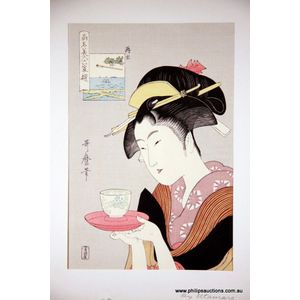Teahouse Waitress by Utamaro
You must be a subscriber, and be logged in to view price and dealer details.
Subscribe Now to view actual auction price for this item
When you subscribe, you have the option of setting the currency in which to display prices to $Au, $US, $NZ or Stg.
- Cartouche - An ornamental panel in the form of of a shield, oval or rectangular scroll with curling edges. It may be carved into the back of a chair or the top of a sideboard, or present on a piece of silver or jewellery, and contain the initials of the original owner, heraldic symbols, or some other inscription, such as the details of a presentation.
In ceramics the term defines the central area of a vase or similar with a decorative border in one of the shapes above, into which a decorative scene or figures have been painted. - Edo Period, Japan - The Edo period in Japan lasted from 1603 to 1868. During this time, Japan was ruled by the Tokugawa shogunate, a military government led by the Tokugawa family. The Edo period is characterized by a period of relative peace, stability, and economic growth, as well as by the development of a distinctive culture and society.
During the Edo period, the capital of Japan was moved from Kyoto to Edo (modern-day Tokyo), and the country became increasingly isolated from the rest of the world. The shogunate implemented strict policies to maintain control, including the restriction of foreign trade and travel. However, despite this isolation, the Edo period saw significant cultural and artistic development, including the emergence of the ukiyo-e woodblock print tradition, the growth of Kabuki theater, and the flourishing of a vibrant merchant culture.
The Edo period ended with the Meiji Restoration of 1868, which saw the collapse of the shogunate and the restoration of imperial rule.
Visually similar items

Sadanobu III, Hasegawa (1881-1963), circa mid 20th century, a geisha, a woodblock in colours on paper with artist's characters and seals with printer's mark, the paper also impressed with patterns. Length 36 cm. Width 24 cm

McTavish Sky Bluebird Twin Fin 1979 model. Swallow tail with flyers. Signed and shaped by Bob McTavish. 5 feet 11 inches long x 20.5 inches.

1933 'The News' full page supplements 'South Australian football Captains', almost complete set [7/8], each 28 x 45 cm. G/VG condition

Hawthorn/Weg Artwork: Preliminary artwork for cover of 1978 Grand Final video, produced and signed by Weg, for Australian Football Video, c1994, size 32 x 46 cm. Together with a photograph of the 1978 Weg poster, used as a basis for the design. Good condit
